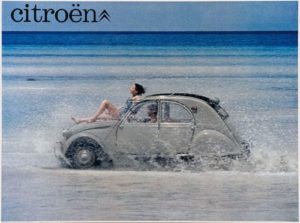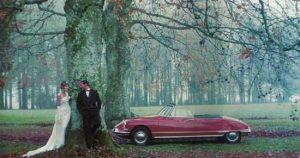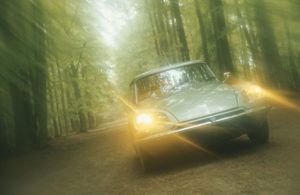The art editor Robert Delpire passed away on September 26, 2017 at the age of 91 after a 70 year career. In 1950, while studying medicine, he transformed the journal de la Maison de la médicine into a high quality, luxury magazine which was funded by pharmaceutical companies. With some friends, he then founded another magazine, Neuf. He was encouraged by his friends, André Breton, Pablo Picasso and Robert Doisneau, Jean-Paul Sartre, Jacques Prévert and Henri Cartier-Bresson all of whom were interested in this magazine which was published for four years. It was clear that medicine was not for him; art direction and editing was to be his new career.
For ten years, between 1960 and 1970, in conjunction with Claude Puech he was responsible for Citroën’s advertising, bringing as fresh an approach to the subject as the manufacturer did to car design. Prior to this, most automotive advertising comprised little more than uninteresting illustrations and specifications; Delpire brought a sense of both art and fun to the subject and in doing so, shocked many at the Citroën head office. Claude Puech had joined the company in 1954 as a sales superintendent but resigned when he realised that he was not cut out for a career in sales. The personnel manager decided to offer him another job within the company – advertising the yet-to-be announced DS19. His style was influenced by the work of Olivetti and IBM and he decided to employ professional photographers and writers and he was also responsible for the design of the DS stand at the 1955 Paris Salon.
Early in 1960, Puech received a visit from Delpire who sought permission to take photographs in the Citroën factory which would be used in a book to be called le grand oeuvre (the great work) which would showcase French industrial sites. Puech was not empowered to give approval so Delpire insisted on speaking to Pierre Bercot who, after discussing Bach, sanctioned the photography. Delpire and Bercot hit it off immediately, sharing as they did a common love of the arts. The book was never published.
Puech had never been entirely happy with the DS promotional material, feeling it to be too conventional, albeit produced to a very high standard. Not wanting to be a slave to fashion, he decided not to give the job to one of the big advertising agencies but instead chose Delpire whose first job was to produce an in-house magazine, Le Double Chevron, intended for dealers.
Delpire’s company, Delpire Publicité used legendary photographers such as Henri Cartier-Bresson and Marc Riboud from the Magnum agency and instructed them to capture Citroen’s cars from new angles and in original contexts. Over the ensuing decade, this led to a series of exceptional brochures and catalogues for the 2CV and DS that were replete with beautiful art and photography.
The first Ami 6 promotional brochure was in monochrome which flew in the face of the four colours norm but did not do so just for the sake of it. The first sentence in the brochure stated “With the Ami 6, Citroen has balanced the qualities of a small car with those of a large one.” Delpire expanded on this, translating into images the reconciliation of two opposites, using differently scaled photographs and close ups in close juxtaposition. This brochure set the tone for much of Delpire’s subsequent work for the company. Stylized close-ups in particular became one of the hallmarks of his handiwork.
In 1962, Delpire’s second Ami 6 brochure took an entirely different tone. Where the first brochure explored the car as machine, the second one majored on the car’s personality. Entitled pour vous madame (for you, madam), it promoted the car to the modern woman who was pictured in scenes at some of the most famous tourist spots in Paris.
Two more different brochures for the same car would be hard to imagine.
Not content with producing brochures, Delpire also designed owner’s manuals.
Delpire’s talent is, in my opinion, nowhere better illustrated than the beautiful D series publications and of these the ultimate was probably the one which portrayed the Décapotable. The photos were by William Klein and follow a loving couple around the grounds of Versailles as they wander along the majestic pathways, through the trees and along wet roads. The atmosphere is intensely romantic, with more than a passing allusion to Jacques Demy’s film Peau d’Ane. The brochure ends late at night in the Champs Elysées, where the lights from passing traffic create fiery starbursts. No advertising copy interferes with this photographic poem although the photos are captioned with quotes such as “Luxury is life most eloquent” (Léon-Paul Fargue).
Delpire used other photographers including André Martin who took more pictures for Citroën than any other photographer. His speciality was action shots with an innovative approach to photographing motion. Using long exposure times he managed to create the sensation of high speed. The result was ground-breaking photographic impressionism.
Delpire Publicité started out with staff that included the layout artist Jacques Monory, and rapidly became the leading agency in its field. Publicity material became Art. Delpire employed many non-French people including Philip Hartley from the UK, Hans Troxler from Switzerland and Gervasio Gallardo from Spain.
Delpire’s work existed on the margins of the world of advertising. It was diametrically opposed to the “loud” advertising so beloved by mainstream agencies.
Citroën’s advertisements did not sing the praises of the product or make any false promises; their cars made nobody any younger, more virile, or attractive. Sophistry and deception were absent. The Delpire years were the absolute antithesis of American advertising where deluding the public was the norm. The principle behind Citroën’s advertising was, according to Jacques Wolgensinger “…to be a truthful language expressing the essence of the product, a genuine intermediary between man and things, and to seek to make better use of life and the objects which are a part of it. The idea is not to slavishly vaunt the merits of a product, but to experiment with ways of talking about it, to express the equivalent of a Citroën in graphic art or in writing”.
The SM and GS marked the end of the road for the association between Delpire and Citroën. The SM’s commercial failure marked the end. The GS had to be sold at all costs, so the company called in marketeers trained in the American school of marketing to take over the advertising. This forced Delpire Publicité to become a ‘proper marketing agency’ running “market surveys”, “targeting” and meeting the “expectations of consumers”. Delpire was unhappy. He was now expected to apply ‘scientific formulae’ and respond to the pulse of public opinion. Within a few months, he was to turn his back on Citroën advertising and the world became poorer as a result.
Alain Poirée, who became director of the Paris ad agency CLM/BDDO, summed up the Delpire years: “All agencies have a function, but Delpire had a mission.”
Delpire is survived by his wife, the photographer Sarah Moon (born Marielle Warin) who was the first woman to take photographs for the Pirelli calendar.
Text submitted by Julian Marsh








1 comment